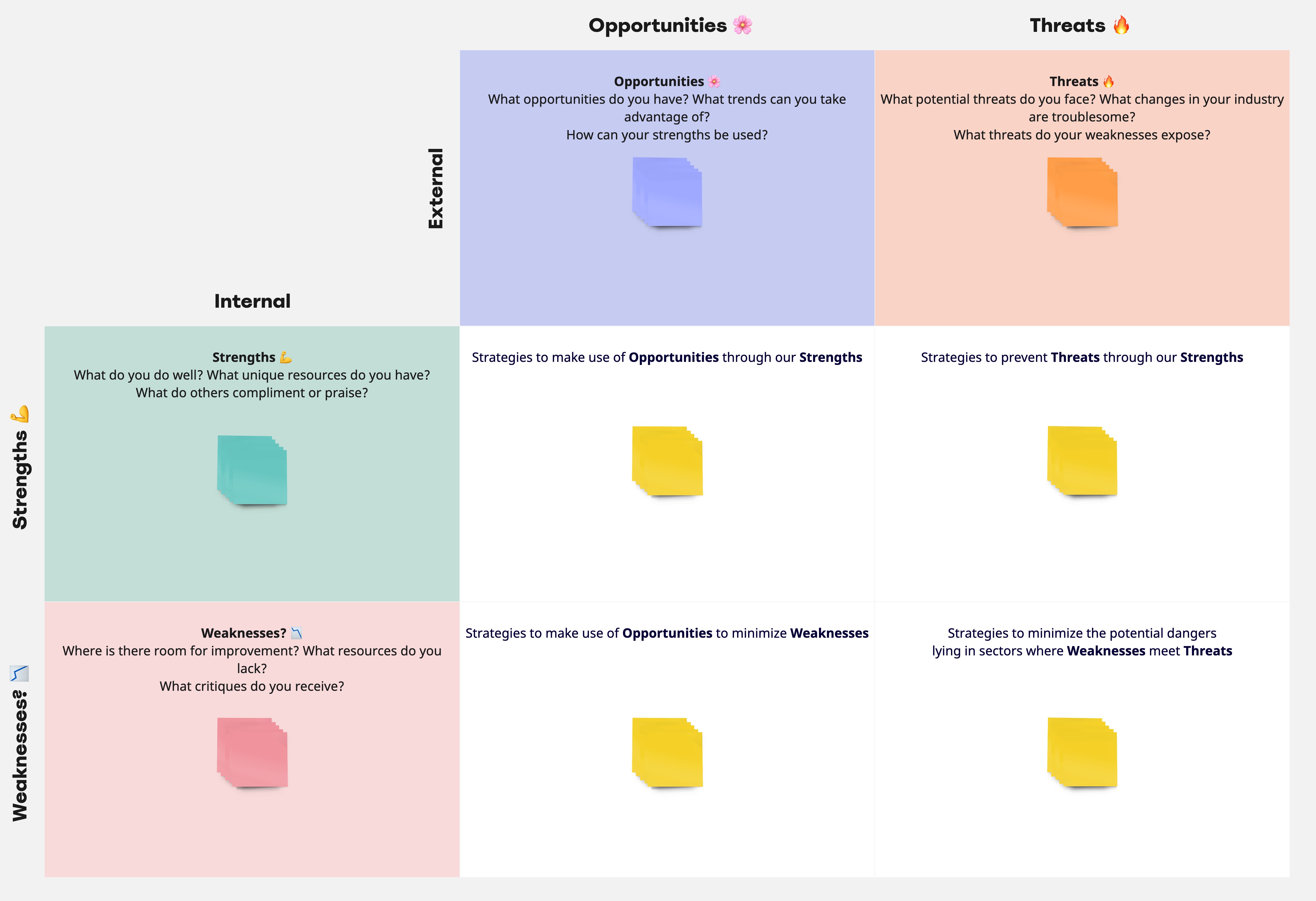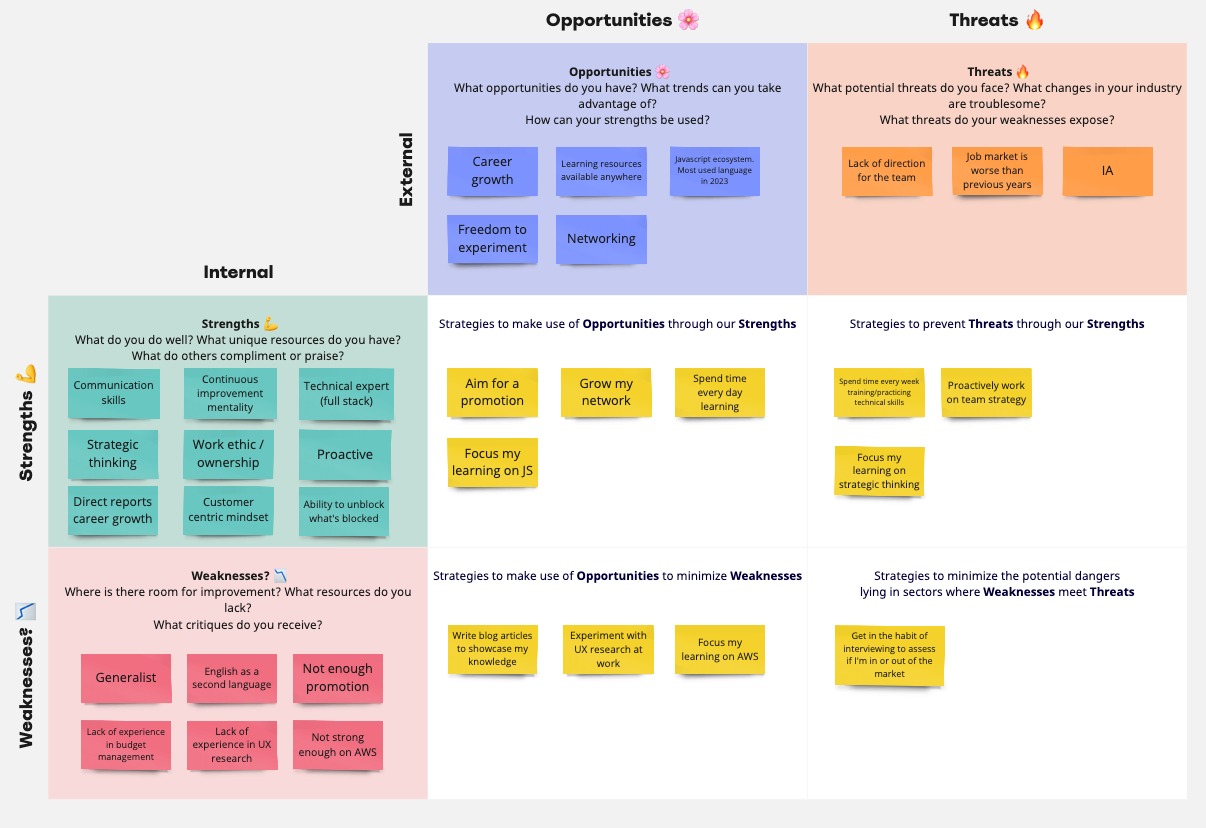Define your strategy
April 2024
Have you ever feel like you’re super busy, spending a lot of time and effort, but you’re just not making progress against the initiatives that are meaningful to you?
This is a common feeling and the root cause is not being able to define, and follow, your strategy. In a previous articles, you have learned about the things you do, and you have learned about how to define your mission. Now, it’s time to translate that mission statement, and the skills and strengths of your team, into a fully defined strategy, so you can spend your time in the things that matter.
With that in mind, let’s get on with it!
The goal is to have a clear path, so you can differentiate between what’s important and what’s not. In order to do that, the first step is to analyse your team strengths, weaknesses, opportunities, and threats (SWOT).
SWOT
When dealing with your strategy, there are internal factors and external factors. Internal factors are your strengths and weaknesses, while external factors guide your opportunities and define your threats.
There are many ways to perform a SWOT analysis. A good one is to use a matrix like this one:

The way to fill this matrix is outside in. You start with either the strength and weaknesses, or the opportunities and threats. My recommendation is to start with the strengths and weaknesses first, since that’s an internal reflection that comes naturally to anyone, while the opportunities and threats might need a bit of brainstorming.
Internal
This section is about how you can influence your strategy. What do you have to offer, what do you need to improve.
Strengths
This is the type of things where you, your team, or your organisation shine. What do you do that gives you a competitive advantage?
If you look at the three buckets exercise, this are the things in the first bucket, and maybe some of the second bucket, but mostly first bucket.
Some examples of strengths:
- Profitable
- Technical expertise
- Business knowledge
Weaknesses
The end goal of this section is to list the areas of improvement that you, your team, or your organisation need. You can identify lack of skills, or resources, but it is also a place to reflect on the ‘not great’ feedback that you get.
Another way to fill this section out is to compare with competitors and check where you are doing worse than them.
Some example of weaknesses:
- Lack of expertise in a particular area
- Not enough resources
- Low market penetration
External
This section is about external forces influencing your strategy.
Opportunities
Opportunities is the first section that’s not about you. Brainstorm how some trends can help you with your goals.
Some examples of opportunities:
- Upward industry trend
- Struggling competitor
- Emerging new technologies
Threats
Threats is the opposite of opportunities. Have a look at what your competitors are doing better than you, or maybe analyse if your industry is in recession, or even if you are facing extinction due to new technologies or business ideas.
Some examples of threads:
- Global economic situation
- IA replacing your product
- Many strong competitors
Strategy
After identifying strengths, weaknesses, opportunities, and threats, it is brainstorming time. Get everyone to come up with different possible strategies for each combination (opportunities based on your strengths, opportunities based on your weaknesses, etc).
For example, if you match your ‘Low market penetration’ weakness with the ‘Upward industry trend’ opportunity, you can think about an strategy to promote your product with the goal to reach to more customers now that the interest in your industry is growing.
You can also see a graphical example of a final board:

After you have come up with a good enough number for each section, take a rest and step back.
Once you’ve conducted your SWOT analysis, it’s time to refine it. You should be looking to synthesize ideas and look for major themes that emerge from the SWOT analysis.
Sort those themes by importance and you got it! You have your strategy defined and prioritised.
For the previous example, the end result might look like this:
- Set strategy for the team
- Continuous learning, with a focus on JS, AWS, and UX research
- Get promoted
- Assess the job market and grow my network
- Periodically write a blog article, with a focus on strategic thinking, and technical skills
That’s all!